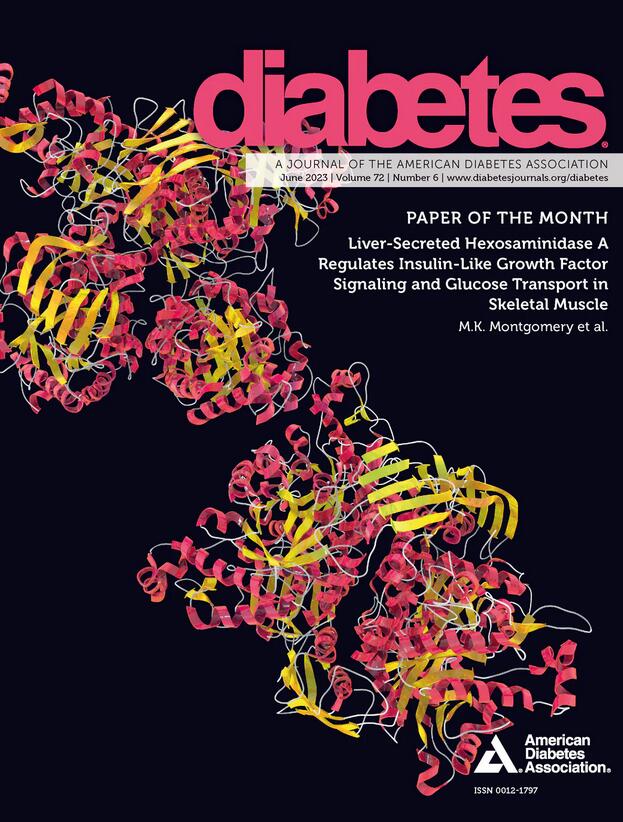Dynamic Ca2+-Dependent Transcription Links Metabolic Stress to Impaired β-Cell Identity
IF 7.5
1区 医学
Q1 ENDOCRINOLOGY & METABOLISM
引用次数: 0
Abstract
By augmenting ATP-sensitive K+ channel–induced membrane depolarization, chronic metabolic stress in prediabetes may increase intracellular Ca2+ concentrations in pancreatic β-cells and cause a loss of cell identity and function. Here, we describe studies of the temporal transcriptomic dynamics induced by sulfonylurea-induced membrane depolarization. Gene expression in isolated islets is highly dynamic, with changes occurring within 30 min of membrane depolarization. Initially, the changes are adaptive and driven mainly by signaling through CREB and several other CREB-dependent transcription factors. However, within several hours, there is a progressive decline in islet function that correlates with the diminished expression of islet identity genes and the expression of dedifferentiation markers, consistent with the responses having become maladaptive. The gene expression adaptations cluster into 19 distinct response patterns driven by multiple transcription factors. We also identify a set of high-concentration glucose/Ca2+-regulated genes and modules of coexpressed genes that are enriched for type 2 diabetes risk genes. Together, these findings establish a close temporal link between membrane depolarization, changes in intracellular Ca2+ concentrations, alterations in the islet transcriptome, and impairments of β-cell identity and function. Article Highlights This study was undertaken to establish a temporal link between an increase in intracellular Ca2+ concentration and the loss of pancreatic β-cell identity. We profiled the alterations in Ca2+ dynamics and gene transcription that occur in freshly isolated islets following membrane depolarization. We show that initially adaptive Ca2+-dependent transcription changes, mediated largely by CREB and CREB-dependent transcription factors, rapidly become maladaptive, causing the loss of β-cell identity and function. We also show that many effector genes linked to nearby human type 2 diabetes susceptibility loci are regulated by Ca2+-dependent mechanisms.动态Ca2+依赖性转录将代谢应激与β细胞身份受损联系起来
通过增加atp敏感的K+通道诱导的膜去极化,糖尿病前期的慢性代谢应激可能增加胰腺β细胞的细胞内Ca2+浓度,导致细胞身份和功能的丧失。在这里,我们描述了磺胺脲诱导的膜去极化诱导的时间转录组动力学的研究。离体胰岛的基因表达是高度动态的,在膜去极化后30分钟内发生变化。最初,这些变化是自适应的,主要由通过CREB和其他几个依赖CREB的转录因子的信号驱动。然而,在几个小时内,胰岛功能逐渐下降,这与胰岛身份基因和去分化标记物的表达减少有关,与反应变得不适应一致。基因表达适应可分为19种不同的响应模式,由多种转录因子驱动。我们还鉴定了一组高浓度葡萄糖/Ca2+调节基因和共表达基因模块,这些基因富集于2型糖尿病风险基因。总之,这些发现建立了膜去极化、细胞内Ca2+浓度变化、胰岛转录组改变和β细胞身份和功能损伤之间的密切时间联系。本研究旨在建立细胞内Ca2+浓度增加与胰腺β细胞身份丧失之间的时间联系。我们分析了在膜去极化后新分离的胰岛中发生的Ca2+动力学和基因转录的变化。我们发现,最初适应性的Ca2+依赖性转录变化,主要由CREB和CREB依赖性转录因子介导,迅速变得不适应,导致β细胞身份和功能的丧失。我们还表明,许多与附近人类2型糖尿病易感位点相关的效应基因受到Ca2+依赖机制的调节。
本文章由计算机程序翻译,如有差异,请以英文原文为准。
求助全文
约1分钟内获得全文
求助全文
来源期刊

Diabetes
医学-内分泌学与代谢
CiteScore
12.50
自引率
2.60%
发文量
1968
审稿时长
1 months
期刊介绍:
Diabetes is a scientific journal that publishes original research exploring the physiological and pathophysiological aspects of diabetes mellitus. We encourage submissions of manuscripts pertaining to laboratory, animal, or human research, covering a wide range of topics. Our primary focus is on investigative reports investigating various aspects such as the development and progression of diabetes, along with its associated complications. We also welcome studies delving into normal and pathological pancreatic islet function and intermediary metabolism, as well as exploring the mechanisms of drug and hormone action from a pharmacological perspective. Additionally, we encourage submissions that delve into the biochemical and molecular aspects of both normal and abnormal biological processes.
However, it is important to note that we do not publish studies relating to diabetes education or the application of accepted therapeutic and diagnostic approaches to patients with diabetes mellitus. Our aim is to provide a platform for research that contributes to advancing our understanding of the underlying mechanisms and processes of diabetes.
 求助内容:
求助内容: 应助结果提醒方式:
应助结果提醒方式:


